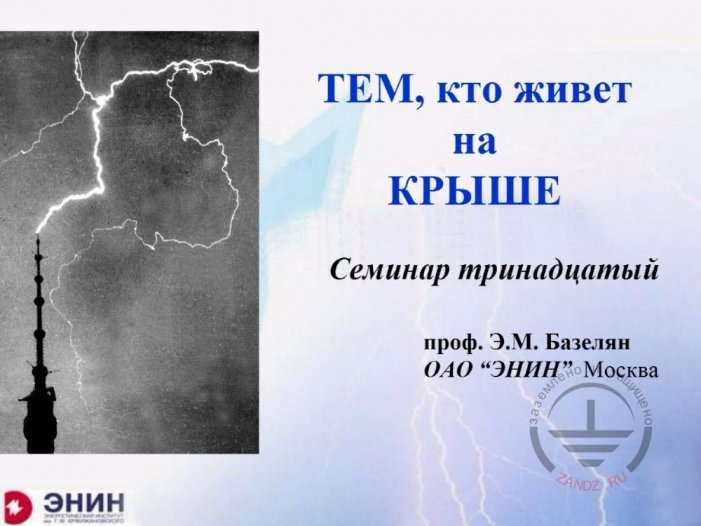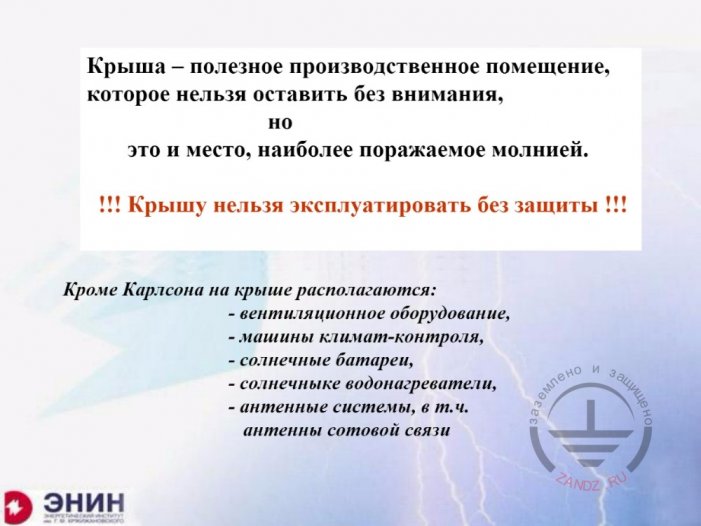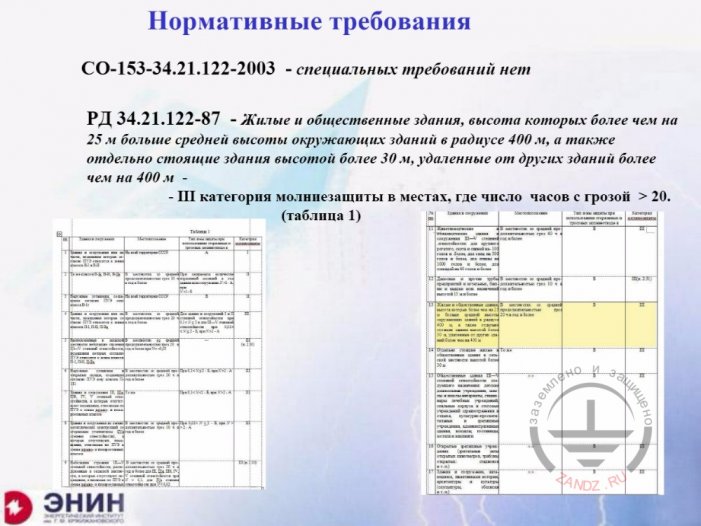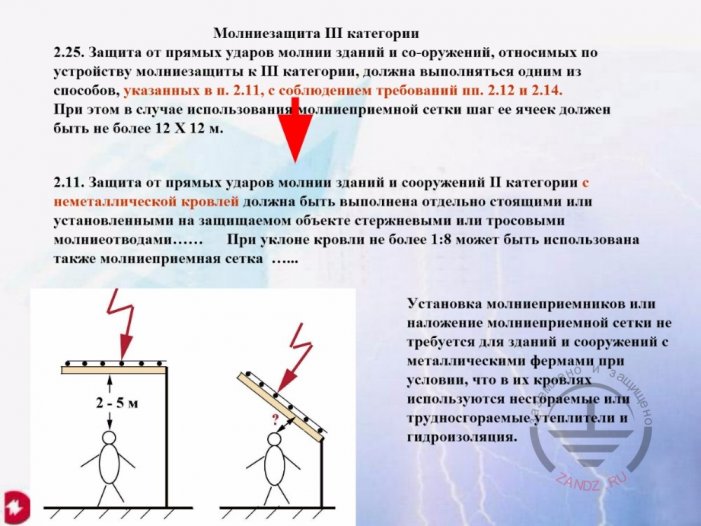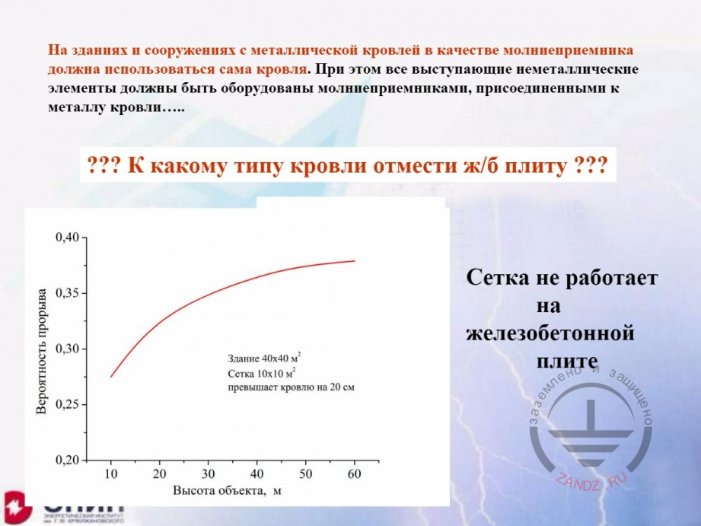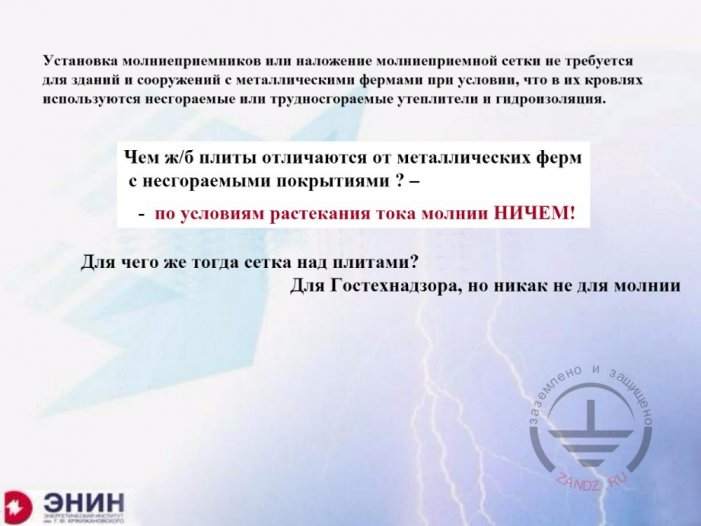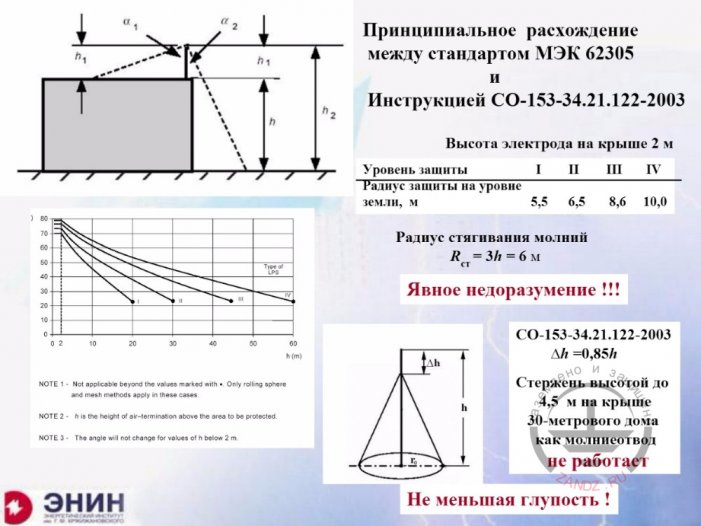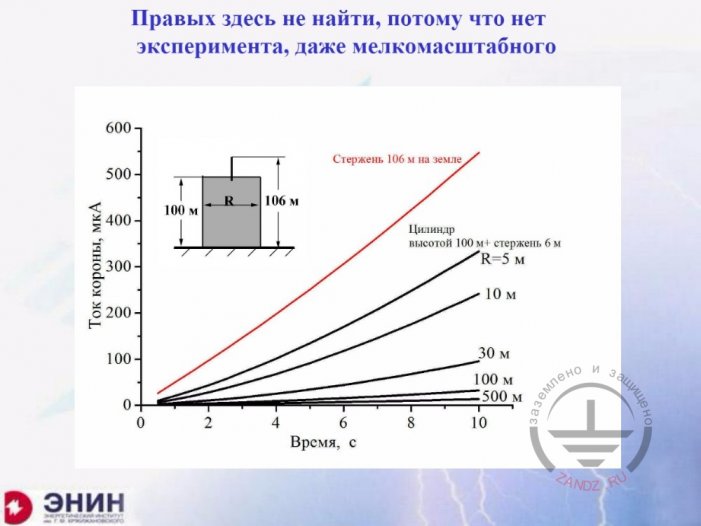The sixteenth webinar of the series "Grounding and lightning protection: questions and answers arising at the design"
(held on October 5, 2016, at 11:00 MSK)
Full-screen mode with the quality of "720p" is recommended.
Today the roof is not only protection from rain and snow, but today technological space is important where climate-control machines and ventillation are placed, antenna systems and other electrical equipment is mounted. It is not a rare thing when the roof turns into a recreation zone with a lot of people on it. There is complex structure roof which should be protected from lightning strikes.
Lightning protection mesh compared to this technical variety used by the designers doesn't look convincing. And it was not without reason.
We offer to start the next webinar from the analysis of mesh possibilities. Designers forget that the mesh is intended only for the protection of buildings with dielectric roof at a certain pitch, when the person is on the top level or in the attic can't get under the dangerous touch voltage. Mesh is not put on metal roof. It's totally useless there. And here the first question arises - to what category to relate reinforce concrete slabs? They do not look like dielectric.
The second crucial question refers to the calculation of protection zones of lightning rods mounted on the roof. The crucial differences between the domestic regulatory documents on lightning protection and IEC 62305 standard. There are not much data about such lightning rods. It is almost useless to wait for new researches and we need to decide right now. The project won't wait.
Installation of lightning rods on the roof will necessarily cause the question about a safe drainage of lightning current into the ground. This issue has two major aspects. First of all, it is necessary to privide security of people inside and near the protected building, reducing step and touch voltage levels. It is far to the good constructive decisions. Television in a thunder season reminds us about that. Secondly, you can hardly meeting a building today which is not full of microprocessor technical devices, which is less resistant to electromagnet lightning impacts. Correct arrangement of lightning protection may help to solve this problem.
Webinar text. Page 1
Quick navigation through slides:
Page 1:
1. For those who live on the roof
2. Useful production room
3. Regulatory requirements
4. Lightning protection of category III
5. Mesh on reinforced concrete slab
6. What do we need mesh over slabs for?
7. The difference between the standard IEC 62305 and IS 153-34.21.122-2003
8. Corona current change diagram
Estimated reading time: 63 minutes
For those who live on the roof
— Today is the thirteen's webinar with Eduard Meerovich Bazelyan, dedicated to protection design. The topic is very interesting - lightning protection of roof, it is a relevant topic which causes many questions, because various systems of climate control are installed on the roofs now, different antennas and even recreation zones and cafes which are very popular during the warm season in the period of thunder activity. Of course, everything should be protected from lightning, so it would be safe to drain lightning current into the ground. And how to do it, if the regulatory documents contain contradictions on this issue and it all causes the problem in the work of designers. Today we will talk to professor Eduard Meerovich Bazelyan and will try to answer all the questions. Please write your questions in the chat and it is preferable to indicate the number of the slide which relates to the question or some phrases of the professor, so he would quickly understand what you are talking about and answer your question in the best way. In order to increase or reduce volume you can point the arrow at the video of the lecturer and adjust the level of volume with the regulator. Also you can zoom in by using green cross magnifier; it is on the toolbar in the bottom under presentation slides. That's all relating to the organizational part. We can begin. Good afternoon, Eduard Meerovich.
— Good afternoon, dear colleagues! It is the thirteenth seminar today. I was a bit nervous about the seminar, not because it is the 13th but because we are going to talk about the roof. And only Carlsson has no problems with the roof. As concerns all the rest people, the situation is not the best. And frankly speaking, the greatest confusions arising today are connected with the roof. I won't be able to answer all questions today, because some of them are simply unsolved on the principal level. And we will have to talk about it and we will need to ask some alternative solutions because you need to design lightning protection today, not in a few years. Though several years ago I had a talk with one very active, young and promising physicist who is seeking the topic of his doctor thesis and I offered him to solve questions with lightning protection of the roof. He was very understanding to that, but was not very enthusiastic because it is really not easy to solve this task. I don't have to explain you what roof is, because roof is really a place which is considered to be a technological space and there is a lot of equipment in this space. But first of all it is traditional machine climate-control and ventilation, practically in all the countries.
Useful production room
Roof is a useful protection room which can’t be left without attention, but this is also the place most frequently hit by lightning.
Roof can’t be used without protection
Besides Carlsson, the following things are located on the roof:
- ventilation equipment
- climate control machines
- solar batteries
- solar hot water tanks
- antenna systems in particular mobile connection antennas
— From the other side - it is antenna system. There can be many of them and they can be very different, in particular they can be very high. And then installation of such an antenna on the roof is not a good deed, because thanks to the increased height of objects in general, you get the increased number of strikes into this antenna. If antenna engineers will tell you: «What are you worried about for Christ sake? Our antenna will take everything on it", please do not believe this idle talk. Antenna will really take everything on itself, but electromagnet pickups from the current which will flow on this antenna will be the same as from the lightning channel. And the impact on this electronic filling of this building which you protect will be very serious and quite large. That is why installation of any antennas on the house should be coordinated and solved from the position of lightning protection.
Regulatory requirements
AD.34.21.122-87 – Residential and public buildings, the height of which is 25 cm higher than the average height of the surrounding buildings within 400 meters in radius, and also free-standing buildings higher than 30 meters, remote from other buildings not more than to 400 m.
III category of lightning protection in places where the number of thunder hours is >20. (table 1)
— What do requirements of our regulatory documents tell? Here we need to start with the new instructions, because the old one was published in 2003. There is no word about the roof except one single one in IS-153-34.21.122. If to look thoroughly you will find such words there that if the roof has metal coating 0,5 mm thick or more, then this roof can be used as a lightning rod. There is no point from these recommendations, because then there is a condition that this roof should be put on a non-flammable coating.
Lightning protection of category III
Lightning protection of category III
2.25 Protection against direct lightning strikes of buildings and structures referred to category III of lightning protection, should be carried out in one of the forms, indicated in p.2.11 with the observation of requirements from point 2.12 and 2.14. And in case of using lightning protection mesh, the distance between the cells should be not more than 12x12 meters.
2.11. Protection against direct lightning strikes of buildings and structures referred to II category of lightning protection with non-metal roof should be carried out by free standing or installed on the protected object rod and catenary wire lightning rods….at the pitch of the roof not more than 1:8 lightning protection mesh can also be used.
Installation of lightning rods or putting of lightning protection mesh is not required for buildings and structures with metal frames providing non-flammable or hard burning thermal insulation or hydro insulation are used in their roofs.
— It is necessary to protect the roof especially if there is technological equipment on it. And if there are people on this roof, for example the roof is a recreation zone, as Alexey has just said, it is necessary to protect it. Then it is necessary to be attentive to what is written in AD 34. I opened this document for a hundred of times. Before this seminar I opened it again in order to see what is required. Item 2.5 in lightning protection tells the following: lightning protection of buildings and structures related to category III of lightning protection from direct lightning strikes should be carried out in one of the following methods indicated in some item. I go to this item and see that it is necessary to carry out protection with the help of free standing rod lightning rods or catenary wire and rod installed on the roof. In case when the roof is non-flammable and has the pitch less than 1/8, metal mesh can be used. We miss two things in our lightning protection practice. The first thing is non-flammable roof. Lightning protection mesh is put anywhere, for example to reinforce concrete slabs. And reinforce concrete slabs can't be considered non-flammable roof. The second circumstance - it is the pitch of the roof. Where did it come from? Why did it appear and where from it was introduced into our regulatory document.
And due to the reason of much metal presence, it is possible to use all that for draining lightning current into the ground.
Mesh on reinforced concrete slab
On buildings and structures with metal roof, the roof itself was used as lightning rods. And non-metal scarcements should be equipped with lightning rods connected to the roof metal.
To what type of roof reinforced concrete slab should be referred?
Вероятность прорыва- breakthrough probability
Здание - building
Сетка - mesh
Превышает кровлю на 20 с – elevates above the roof to 20 cm
Высота объекта, м – object height, m
Сетка не работает на железобетонной плите- Mesh doesn’t work on reinforced concrete slab
— What to do with the mesh? You are forced to put the mesh. You are putting this mesh on reinforced concrete slabs, what for? What can this mesh protect? We returned to this question many times, maybe even at the first seminar we talked about what mesh can do if it is put on reinforced concrete slab. It is supposed that there will be some insulation layer on the reinforced concrete slab and it can be hydro insulation, maybe thermal insulation, but the thickness of this coating will be hardly greater than 1-2 cm, as a rule even less. With such an elevation, this mesh doesn't protect from anything. We made a numerical modelling of such a form: we took a building 40x40 meters in square, took its height from 10 to 60 meters, considered that there is hydro insulation coating of incredible thickness of about 20 cm on the reinforced concrete slabs of this building and looked how many lightning will miss this mesh and hit the reinforced concrete slab. It turned out that 35-40% of lightning will miss the mesh. So there is no protection from mesh at all. What to put it for? I have one answer to this question and it will disappoint you.
What do we need mesh over slabs for?
Installation of lightning rods or putting of lightning protection mesh is not required for buildings and structures with metal frames providing non-flammable or hard burning thermal insulation or hydro insulation are used in their roofs.
What is the difference between the reinforced concrete slabs and metal frames with non-flammable coating?
According to the conditions of lightning current flowing- there is no difference
What is mesh over the slabs for? For GosTekhnadzor, but not for lighting
— I think the only function which the mesh performs - it provides lack of scandals with Gostekhnadzor. The mesh is really necessary for that. You won't get along without it, so you won't be able to convince Gostekhnadzor that AD 34 interpretation is absolutely incorrect. In any case, we did not manage to. Does the mesh have any useful feature? It does, but it doesn't relate to protection from direct lightning strikes and electromagnet environment inside the building. In order to ease the electromagnet environment and keep the electronic devices, which are inside the residential building or in the office building, you need to weaken the magnet field as much as possible.
The difference between the standard IEC 62305 and IS 153-34.21.122-2003
Principal difference between the standard IEC 62305 and IS -153-34.21.122-2003
Height of the electrode on the roof 2 m
Уровень защиты - protection level
Радиус защиты на уровне земли, м- protection radius at the ground level, m
Радиус стягивания молний – lightning contraction radius
Явное недоразумение – obvious mistake
Стержень высотой до 4,5 м на крыше 30 метрового дома как молниеотвод не работает – the rod 3,4 m high on the roof of a 30-meter house doesn’t work as a lightning rod
Не меньшая глупость- also a stupidity
— Now if we seriously talk about lightning protection, then problem begins with the very beginning. There is a picture in front of you, which I took from IEC standard. On this picture, the lightning rod installed on the roof counts its height from the roof level, if to talk about protective action of what is located on the roof. And it counts its height from the ground, if we talk about protection by this lightning rod placed on the ground. IEC interprets lightning protection this way. How do Russian documents interpret lightning protection for a lightning rod installed on the roof? In a completely different way. Wherever you have a lightning rod installed, on whatever roof it stands, at the edge or in the middle of the roof- it doesn't really matter. Its height is counted from the ground level. Neither this, nor that can be considered correct. It is some convention which was accepted this way in one place and in Russia- in another way. What will it bring to? Let's study IEC standard first. I want to protect everything that is placed on the roof by the lightning rod installed on it. Then the height of this lightning rod can be very small, mine is not high, about 2 meters. The protective angle which defines the straight pitch, which limits the protection zone, turns out to be very large. This angle is in the range of 70 to 80 degrees. If you multiply the lightning rod height to the tangent of the pitch angle, then protection zone radius at the ground surface will be of a very large size. See, for the first lightning protection level for a two-meter-high lightning rod it is at the level of 5,5 meters, and for the third protection level, which is more often applied in practice in residential buildings is 8 meters. What do 8 meters of radio protection mean? There is a known parameter: lightning attracts lightning strikes from the radius equal to the three-times height of the lightning rod. It means that for a two-meter lightning rod, the radius of lightning contraction is 6 meters and the protection radius is 8 meters according to IEC, this is a complete absurd. How can it be so? Lightning get constricted only from a smaller distance, and greater distance is protected. It is impossible and absolutely incorrect. And it is clear that it will depend on anything else. What is the size of the roof? Is it big or small? Where does the lightning rod stand? In the middle of the roof or somewhere on the side? It is absolutely unclear too. Russian protection zone brings to another stupidity, you see here is a 10-floor building 30 meters high here. I put a lightning rod on this 10-floor building, but according to the Russian regulations, protection zone starts below the top of the lightning rod and below the top for the reliability of protection of 0,9- is 15%. So if I have a lightning rod 4,5 meters high on my roof, it doesn't protect anything and anybody at all. It is according to the Russian regulations. This is absurd too. This absurd tells that our Russian regulations and IEC standard regulations are made without some serious physical ground.
Corona current change diagram
Nobody is right here, because there is no experiment, even a small one
Ток короны. мкА – Corona current, mA
Стержень 1-6 м на земле – Rod 1-6 meters on the ground
Цилиндр высотой 100 м + стержень 6 м – Cylinder 100 m high + rod 6 m high
Время, с – time, s
— And this physical ground should be found. I tried to show you how serious it is in 5 minutes. I studied this task. I have a 100-meter building and there is a lightning rod 6 meters high on it. How does this lightning rod contract lightning? We've been talking about it many times, it contracts lightning because the gas-discharge process develops from the top of the lightning rod towards the lightning channel, which forms the plasma channel and this channel is called a counter leader. Before this channel appears the corona is formed from the top of this lightning rod in the electric field of a thunder cloud. How do characteristics of this corona differ from the size of the roof on which the lightning rod stands. What do we get here?
Next Page >>
slides 9 to 15
Useful materials for designers:
- Webinars with the leading industry experts
- Everything for the calculation of grounding and lightning protection
- Useful materials: articles, recommendations, examples
Related Articles:
 Lightning Protection of Large Territories: Parks, Grounds, Plant Territories. Page 1
Lightning Protection of Large Territories: Parks, Grounds, Plant Territories. Page 1
 Lightning Protection of Large Territories: Parks, Grounds, Plant Territories. Page 2
Lightning Protection of Large Territories: Parks, Grounds, Plant Territories. Page 2
 Lightning Protection of Large Territories: Parks, Grounds, Plant Territories. Page 3
Lightning Protection of Large Territories: Parks, Grounds, Plant Territories. Page 3
 6. How to do that?
6. How to do that?


